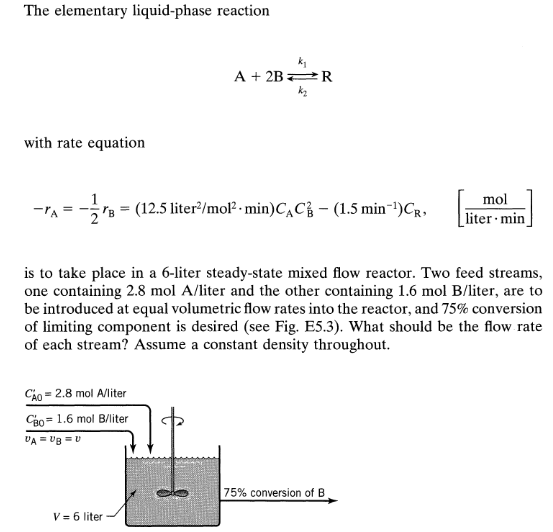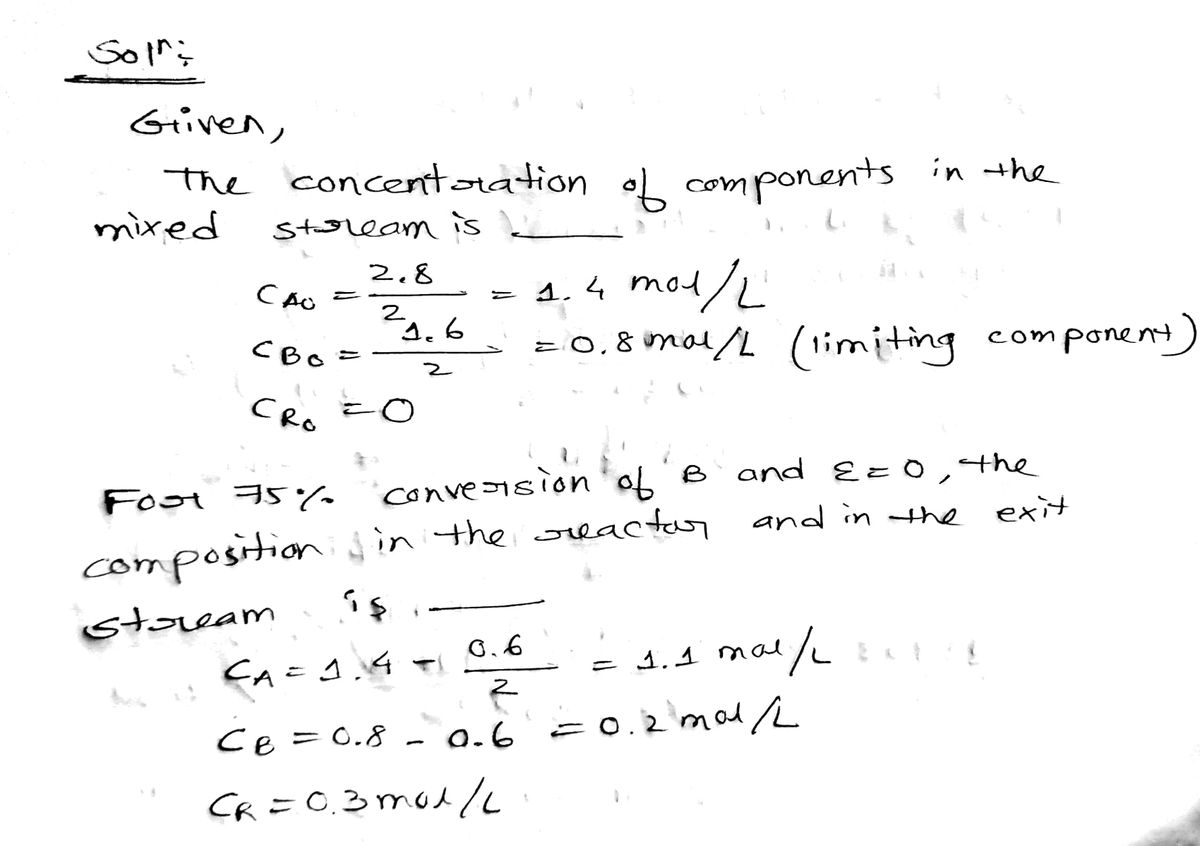The elementary liquid-phase reaction with rate equation k₂ A + 2B R = (12.5 liter²/mol² min)CAC- (1.5 min-¹)CR, CAO = 2.8 mol A/liter Cao = 1.6 mol B/liter VA UBU V = 6 liter is to take place in a 6-liter steady-state mixed flow reactor. Two feed streams, one containing 2.8 mol A/liter and the other containing 1.6 mol B/liter, are to be introduced at equal volumetric flow rates into the reactor, and 75% conversion of limiting component is desired (see Fig. E5.3). What should be the flow rate of each stream? Assume a constant density throughout. mol liter min 75% conversion of B
The elementary liquid-phase reaction with rate equation k₂ A + 2B R = (12.5 liter²/mol² min)CAC- (1.5 min-¹)CR, CAO = 2.8 mol A/liter Cao = 1.6 mol B/liter VA UBU V = 6 liter is to take place in a 6-liter steady-state mixed flow reactor. Two feed streams, one containing 2.8 mol A/liter and the other containing 1.6 mol B/liter, are to be introduced at equal volumetric flow rates into the reactor, and 75% conversion of limiting component is desired (see Fig. E5.3). What should be the flow rate of each stream? Assume a constant density throughout. mol liter min 75% conversion of B
Introduction to Chemical Engineering Thermodynamics
8th Edition
ISBN:9781259696527
Author:J.M. Smith Termodinamica en ingenieria quimica, Hendrick C Van Ness, Michael Abbott, Mark Swihart
Publisher:J.M. Smith Termodinamica en ingenieria quimica, Hendrick C Van Ness, Michael Abbott, Mark Swihart
Chapter1: Introduction
Section: Chapter Questions
Problem 1.1P
Related questions
Question

Transcribed Image Text:The elementary liquid-phase reaction
with rate equation
A + 2B R
B = (12.5 liter²/mol² min)CAC (1.5 min-¹) CR,
CÃO = 2.8 mol A/liter
CB0= 1.6 mol B/liter
VA = VB = V
V = 6 liter
is to take place in a 6-liter steady-state mixed flow reactor. Two feed streams,
one containing 2.8 mol A/liter and the other containing 1.6 mol B/liter, are to
be introduced at equal volumetric flow rates into the reactor, and 75% conversion
of limiting component is desired (see Fig. E5.3). What should be the flow rate
of each stream? Assume a constant density throughout.
mol
liter min
75% conversion of B
Expert Solution
Step 1

Trending now
This is a popular solution!
Step by step
Solved in 2 steps with 2 images

Recommended textbooks for you

Introduction to Chemical Engineering Thermodynami…
Chemical Engineering
ISBN:
9781259696527
Author:
J.M. Smith Termodinamica en ingenieria quimica, Hendrick C Van Ness, Michael Abbott, Mark Swihart
Publisher:
McGraw-Hill Education

Elementary Principles of Chemical Processes, Bind…
Chemical Engineering
ISBN:
9781118431221
Author:
Richard M. Felder, Ronald W. Rousseau, Lisa G. Bullard
Publisher:
WILEY

Elements of Chemical Reaction Engineering (5th Ed…
Chemical Engineering
ISBN:
9780133887518
Author:
H. Scott Fogler
Publisher:
Prentice Hall

Introduction to Chemical Engineering Thermodynami…
Chemical Engineering
ISBN:
9781259696527
Author:
J.M. Smith Termodinamica en ingenieria quimica, Hendrick C Van Ness, Michael Abbott, Mark Swihart
Publisher:
McGraw-Hill Education

Elementary Principles of Chemical Processes, Bind…
Chemical Engineering
ISBN:
9781118431221
Author:
Richard M. Felder, Ronald W. Rousseau, Lisa G. Bullard
Publisher:
WILEY

Elements of Chemical Reaction Engineering (5th Ed…
Chemical Engineering
ISBN:
9780133887518
Author:
H. Scott Fogler
Publisher:
Prentice Hall


Industrial Plastics: Theory and Applications
Chemical Engineering
ISBN:
9781285061238
Author:
Lokensgard, Erik
Publisher:
Delmar Cengage Learning

Unit Operations of Chemical Engineering
Chemical Engineering
ISBN:
9780072848236
Author:
Warren McCabe, Julian C. Smith, Peter Harriott
Publisher:
McGraw-Hill Companies, The